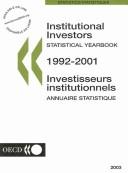| Listing 1 - 10 of 452 | << page >> |
Sort by
|
Periodical
ISSN: 11397535 Year: 2005 Publisher: Madrid : Bolsa de Madrid,
Abstract | Keywords | Export | Availability | Bookmark
 Loading...
Loading...Choose an application
- Reference Manager
- EndNote
- RefWorks (Direct export to RefWorks)
Securities --- Stock exchanges --- Bolsa de Madrid --- Bolsa de Madrid. --- Spain
Periodical
Abstract | Keywords | Export | Availability | Bookmark
 Loading...
Loading...Choose an application
- Reference Manager
- EndNote
- RefWorks (Direct export to RefWorks)
Provides information on the business of institutional global securities trading. Covers the broad spectrum of activities that buy-side firms undertake to implement their investment decisions and manage the investment process end-to-end in order to reduce market impact costs and maximise portfolio returns.
Securities industry --- Stock exchanges --- Electronic trading of securities

ISBN: 1280357134 9786610357130 9264012230 9264012222 Year: 2005 Publisher: Paris : OECD,
Abstract | Keywords | Export | Availability | Bookmark
 Loading...
Loading...Choose an application
- Reference Manager
- EndNote
- RefWorks (Direct export to RefWorks)
Central Asia's securities markets remain small-scale and underdeveloped. Building up well functioning securities markets will be essential to vitalising their economies. This publication contains an overview of securities markets in the region and selected country reports. It provides comprehensive data and analyses of securities markets in the region, updated to April 2005, addressing specifically effective measures to develop securities markets and infrastructure, especially the role of institutional investors and clearing and settlement systems; building investor confidence; and regulation and supervision of securities markets.
Capital market -- Asia, Central -- Case studies. --- Capital markets -- Asia, Central -- Case studies. --- Stock exchanges -- Asia, Central. --- Stock exchanges -- Azerbaijan. --- Capital market --- Stock exchanges --- Bulls and bears --- Commercial corners --- Corners, Commercial --- Equity markets --- Exchanges, Securities --- Exchanges, Stock --- Securities exchanges --- Stock-exchange --- Stock markets --- Capital markets --- Market, Capital --- Efficient market theory --- Speculation --- Finance --- Financial institutions --- Loans --- Money market --- Securities --- Crowding out (Economics) --- Azerbaijan --- Mongolia --- Marché financier --- Bourse --- Case studies. --- Cas, Etudes de --- -Stock exchanges --- -Capital market
Book
ISBN: 146233671X 1452794561 1283516160 1451906773 9786613828613 Year: 2005 Publisher: Washington, D.C. : International Monetary Fund,
Abstract | Keywords | Export | Availability | Bookmark
 Loading...
Loading...Choose an application
- Reference Manager
- EndNote
- RefWorks (Direct export to RefWorks)
This paper assesses whether regional cooperation and integration of stock exchanges in eastern and southern Africa could offer a way of overcoming impediments to the exchanges' development. The paper concludes that regional cooperation and, at a later stage, integration, if carried out at the right pace and in a pragmatic way, could improve the liquidity, efficiency, and competitiveness of these exchanges. Further progress in developing national financial markets must precede any actual moves to integrate securities markets. These exchanges could meanwhile benefit from closer cooperation, including by encouraging more crossborder listings and information/technology sharing.
Electronic books. -- local. --- Stock exchanges -- Africa, Eastern. --- Stock exchanges -- Africa, Southern. --- Exports and Imports --- Finance: General --- General Financial Markets: General (includes Measurement and Data) --- Financial Aspects of Economic Integration --- Finance --- International economics --- Stock markets --- Capital markets --- Securities markets --- Regional integration --- Capital market integration --- Stock exchanges --- Capital market --- International economic integration --- South Africa

ISBN: 1280169877 9786610169870 9264020004 9264019898 Year: 2004 Publisher: Paris, Cedex, France : OECD,
Abstract | Keywords | Export | Availability | Bookmark
 Loading...
Loading...Choose an application
- Reference Manager
- EndNote
- RefWorks (Direct export to RefWorks)
Institutional investors (insurance companies, pension funds, and investment companies) are major collectors of savings and suppliers of funds to financial markets. The role of institutional investors as financial intermediaries and their impact on investment strategies has grown significantly over recent years along with deregulation and globalisation of financial markets.
Institutional investments -- OECD countries -- Statistics -- Periodicals. --- Institutional investments -- Statistics -- Periodicals. --- Stock exchanges -- Periodicals. --- Investments. --- Investing --- Investment management --- Portfolio --- Finance --- Disinvestment --- Loans --- Saving and investment --- Speculation
Book
ISBN: 1462336833 1452768412 Year: 1994 Publisher: Washington, D.C. : International Monetary Fund,
Abstract | Keywords | Export | Availability | Bookmark
 Loading...
Loading...Choose an application
- Reference Manager
- EndNote
- RefWorks (Direct export to RefWorks)
In this paper, we derive evidence on the integration of international stock markets from the cointegration properties of international stock market prices. Using the multivariate cointegration test of Johansen, we find that the set of six country stock price indices, including that of the United States, Canada, the United Kingdom, France, Germany, and Japan are cointegrated. The results suggest that there are long-run equilibrium relationships among the stock market prices. Subsample and subgroup analyses also indicate that the cointegration relationships have become stronger over time. This is consistent with greater stock market integration amid the increasing liberalization and globalization of capital markets.
Asset prices --- Capital market --- Deflation --- Finance --- Finance: General --- Financial markets --- General Financial Markets: General (includes Measurement and Data) --- Inflation --- International capital markets --- International Financial Markets --- Macroeconomics --- Price Level --- Prices --- Securities markets --- Stock exchanges --- Stock markets --- United States
Book
ISBN: 1462389112 1452723877 1282557955 1451912463 9786613822222 Year: 2007 Publisher: Washington, D.C. : International Monetary Fund,
Abstract | Keywords | Export | Availability | Bookmark
 Loading...
Loading...Choose an application
- Reference Manager
- EndNote
- RefWorks (Direct export to RefWorks)
Small emerging economies, despite their significant growth, lack the scale to develop thriving capital markets from their local investor and issuer base that are able to deliver the benefits of a large, mature market. Slovenia is such an example. Despite the necessary infrastructure in place, trading has remained thin and issuance activity has been dormant. This paper proposes a two-pronged strategy for capital market development that leverages the existing setup in the context of regional integration such as within the EU. While using the case of Slovenia, this path might be indicative for other small countries that are part of a larger economically integrated region.
Finance: General --- Investments: General --- General Financial Markets: General (includes Measurement and Data) --- Finance --- Investment & securities --- Capital markets --- Stock markets --- Financial integration --- Securities markets --- Securities --- Capital market --- Stock exchanges --- International finance --- Financial instruments --- Slovenia, Republic of
Book
ISBN: 1462327699 1452737096 1282108212 9786613801562 1451901461 Year: 2003 Publisher: Washington, D.C. : International Monetary Fund,
Abstract | Keywords | Export | Availability | Bookmark
 Loading...
Loading...Choose an application
- Reference Manager
- EndNote
- RefWorks (Direct export to RefWorks)
Using the ARFIMA-FIGARCH model, this paper studies the efficiency of the Japanese equity market by examining the statistical properties of the return and volatility of the Nikkei 225. It shows that both follow a long range dependence, which stands against the efficient market hypothesis (EMH). The result is valid for all sample periods, suggesting that the recent equity market reform has not produced major efficiency gains.
Finance: General --- Investments: Stocks --- Pension Funds --- Non-bank Financial Institutions --- Financial Instruments --- Institutional Investors --- General Financial Markets: General (includes Measurement and Data) --- Investment & securities --- Finance --- Stocks --- Stock markets --- Financial institutions --- Financial markets --- Stock exchanges --- Japan
Book
ISBN: 1462397468 1455215163 Year: 1989 Publisher: Washington, D.C. : International Monetary Fund,
Abstract | Keywords | Export | Availability | Bookmark
 Loading...
Loading...Choose an application
- Reference Manager
- EndNote
- RefWorks (Direct export to RefWorks)
This paper investigates linkages between stock markets in seven industrialized countries since 1974. Empirical evidence shows that both nominal and real stock prices (and returns) are strongly positively correlated across countries, and that nominal exchange rate changes do not have systematic effects on nominal stock prices. A two-country theoretical model is developed and an attempt is made to reconcile the empirical findings with the properties of this model. Independent evidence on the main sources of shocks is used to argue that the time-varying correlation in the data can be reconciled with the predictions of the theory.
Asset prices --- Currency --- Deflation --- Exchange rate adjustments --- Exchange rates --- Finance --- Finance: General --- Financial markets --- Foreign Exchange --- Foreign exchange --- General Financial Markets: General (includes Measurement and Data) --- Inflation --- Macroeconomics --- Price Level --- Prices --- Real exchange rates --- Stock exchanges --- Stock markets --- Japan
Book
ISBN: 1462337732 1451984340 1282108085 9786613801432 1451905610 Year: 2005 Publisher: Washington, D.C. : International Monetary Fund,
Abstract | Keywords | Export | Availability | Bookmark
 Loading...
Loading...Choose an application
- Reference Manager
- EndNote
- RefWorks (Direct export to RefWorks)
In a liquid financial market, investors are able to sell large blocks of assets without substantially changing the price. We document a steep drop in the liquidity of the Japanese stock market in the post-bubble period and a steep rise in liquidity risk. We find that, during Japan's deflationary period, firms with more liquid balance sheets were less exposed to stock market liquidity risk, while slowly growing firms were highly exposed to liquidity shocks. Also, aggregate liquidity had macroeconomic effects on aggregate demand through its effect on money demand.
Electronic books. -- local. --- Liquidity (Economics). --- Macroeconomics. --- Stock exchanges -- Japan. --- Banks and Banking --- Finance: General --- Portfolio Choice --- Investment Decisions --- General Financial Markets: General (includes Measurement and Data) --- Financing Policy --- Financial Risk and Risk Management --- Capital and Ownership Structure --- Value of Firms --- Goodwill --- Financial Markets and the Macroeconomy --- Finance --- Financial services law & regulation --- Liquidity --- Stock markets --- Liquidity indicators --- Liquidity risk --- Market capitalization --- Economics --- Stock exchanges --- Financial risk management --- Financial services industry --- Japan --- Liquidity (Economics)
| Listing 1 - 10 of 452 | << page >> |
Sort by
|

 Search
Search Feedback
Feedback About UniCat
About UniCat  Help
Help News
News